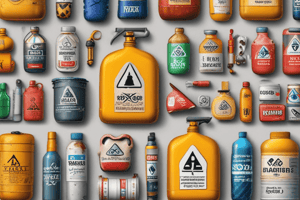Podcast
Questions and Answers
What is the primary purpose of IATA's Dangerous Goods Regulations (DGR)?
What is the primary purpose of IATA's Dangerous Goods Regulations (DGR)?
- To train personnel in handling hazardous materials
- To classify hazardous materials into nine categories
- To provide guidelines for the safe transport of hazardous materials by air (correct)
- To design and construct packaging for hazardous materials
Which of the following is a category of hazardous materials classified by IATA?
Which of the following is a category of hazardous materials classified by IATA?
- Non-toxic substances
- Radioactive liquids
- Electrical materials
- Flammable solids (correct)
What is a requirement for the handling of hazardous materials?
What is a requirement for the handling of hazardous materials?
- Personnel must be trained to handle hazardous materials safely
- Handling procedures must be in place to prevent accidents
- Equipment and facilities must be designed and maintained to handle hazardous materials
- All of the above (correct)
What is a requirement for the packaging of hazardous materials?
What is a requirement for the packaging of hazardous materials?
What is a requirement for the storage of hazardous materials?
What is a requirement for the storage of hazardous materials?
Why may operators have additional or more restrictive requirements for the transport of hazardous materials?
Why may operators have additional or more restrictive requirements for the transport of hazardous materials?
What is a requirement for labeling hazardous materials?
What is a requirement for labeling hazardous materials?
What is the basis for IATA's Dangerous Goods Regulations (DGR)?
What is the basis for IATA's Dangerous Goods Regulations (DGR)?
Flashcards are hidden until you start studying
Study Notes
Hazardous Materials Classification
- IATA classifies dangerous goods into 9 categories based on the type of hazard:
- Class 1: Explosives
- Class 2: Gases
- Class 3: Flammable liquids
- Class 4: Flammable solids
- Class 5: Oxidizing substances
- Class 6: Toxic substances
- Class 7: Radioactive materials
- Class 8: Corrosive substances
- Class 9: Miscellaneous hazardous materials
- Sub-classes exist within each category to further specify the hazard
Air Transport Regulations
- IATA's Dangerous Goods Regulations (DGR) provide guidelines for the safe transport of hazardous materials by air
- DGR is based on the International Civil Aviation Organization (ICAO) Technical Instructions
- Regulations cover:
- Classification and identification of hazardous materials
- Packaging and labeling requirements
- Handling and storage procedures
- Training and documentation requirements
- Provisions for specific types of hazardous materials
Packing And Labeling
- Packaging:
- Must be designed and constructed to prevent leakage or rupture during transport
- Must be compatible with the hazardous material being transported
- Must be marked with the correct UN identification number
- Labeling:
- Labels must be affixed to the packaging and include the correct hazard label
- Labels must be in the correct language and format
- Additional markings may be required, such as "Dangerous Goods" or "Cargo Aircraft Only"
Handling And Storage
- Handling:
- Personnel must be trained to handle hazardous materials safely
- Handling procedures must be in place to prevent accidents and spills
- Equipment and facilities must be designed and maintained to handle hazardous materials
- Storage:
- Storage facilities must be designed and constructed to prevent leakage or rupture
- Storage areas must be segregated from other cargo and personnel
- Access to storage areas must be restricted to authorized personnel
Operator Variations
- Operators may have additional or more restrictive requirements for the transport of hazardous materials
- Operators may have specific procedures for handling and storing hazardous materials
- Operators may have specific training programs for personnel handling hazardous materials
- Operators must comply with IATA's DGR and any applicable national or international regulations
Hazardous Materials Classification
- 9 categories of hazardous materials classified by IATA based on type of hazard
- Class 1: Explosives
- Class 2: Gases
- Class 3: Flammable liquids
- Class 4: Flammable solids
- Class 5: Oxidizing substances
- Class 6: Toxic substances
- Class 7: Radioactive materials
- Class 8: Corrosive substances
- Class 9: Miscellaneous hazardous materials
- Sub-classes exist within each category to further specify the hazard
Air Transport Regulations
- IATA's Dangerous Goods Regulations (DGR) provide guidelines for safe transport of hazardous materials by air
- DGR based on International Civil Aviation Organization (ICAO) Technical Instructions
- Regulations cover classification, packaging, labeling, handling, storage, training, and documentation
Packing and Labeling
- Packaging must be designed and constructed to prevent leakage or rupture during transport
- Packaging must be compatible with the hazardous material being transported
- Packaging must be marked with the correct UN identification number
- Labels must be affixed to the packaging and include the correct hazard label
- Labels must be in the correct language and format
- Additional markings may be required, such as "Dangerous Goods" or "Cargo Aircraft Only"
Handling and Storage
- Personnel must be trained to handle hazardous materials safely
- Handling procedures must be in place to prevent accidents and spills
- Equipment and facilities must be designed and maintained to handle hazardous materials
- Storage facilities must be designed and constructed to prevent leakage or rupture
- Storage areas must be segregated from other cargo and personnel
- Access to storage areas must be restricted to authorized personnel
Operator Variations
- Operators may have additional or more restrictive requirements for hazardous materials transport
- Operators may have specific procedures for handling and storing hazardous materials
- Operators may have specific training programs for personnel handling hazardous materials
- Operators must comply with IATA's DGR and applicable national or international regulations
Studying That Suits You
Use AI to generate personalized quizzes and flashcards to suit your learning preferences.




